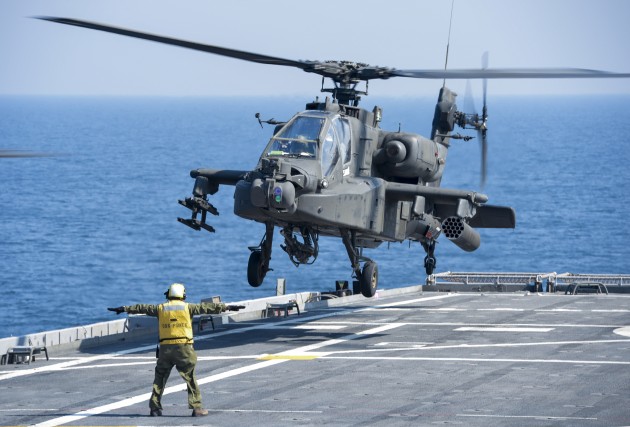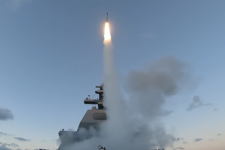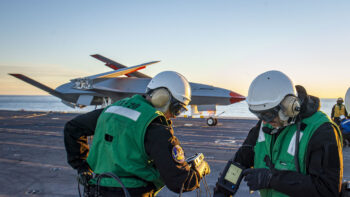
A US Army Apache helicopter lands on a Navy ship in the Persian Gulf region.
CAPITOL HILL: With half a million soldiers on active duty, you’d think the Army would be hard to overlook. When the House Armed Services Committee organized a hearing on the hot interservice concept known as “Air-Sea Battle,” though, they kind of forgot to invite the Army. But the largest service elbowed its way onto the panel at the last moment. What’s more, its representative turned out to be the most engaged, engaging, and enthusiastic person there.
“Some might be surprised that an Amy general would be before Congress talking about Air-Sea Battle, and I confess I’m a little surprised myself to be here,” said Maj. Gen. Gary Cheek in his opening remarks. (Skip ahead to 35:00 in the video of the hearing). He was also the one witness not to read from a prepared written statement, which made him sound much less robotic.
“But I would frankly tell you that, for the Army, we look forward to any and every opportunity to partner with our joint brothers and sisters,” Cheek continued. “This is really what makes our military unique, is the fact we can bring these pieces together.”
That wasn’t the subcommittee’s original plan. In fact, there was no one from the Army on the original witness list and the hearing title still refers to “USAF, USN, and USMC Development of Air/Sea Battle.” It’s not an unforgiveable oversight, since the Seapower and Projection Forces subcommittee mostly deals with the Navy, the Marine Corps and some Air Force programs. But it was a telling oversight all the same. Even more telling was the Army’s eagerness to get involved.
“We were added in,” Cheek told me frankly after the hearing. When it comes to Air-Sea Battle, he said, “we’re a charter member, we’re a part of this, and we want the Army to present when the other services are as well.”
The other participants played predictable roles that spoke volumes about the politics of Air-Sea Battle. The Navy and Air Force representatives emphasized how well they were cooperating across all the services, but especially with each other, in wargaming and concept development. The Marines emphasized their uniqueness and how it made them essential both to Air-Sea Battle and to many other missions; that’s the kind of one-foot-in, one-foot-out approach that has characterized the Marines’ stance on both Air-Sea Battle and the “Strategic Landpower” effort led by the Army and Special Operations Command.
On the subcommittee itself, Chairman Randy Forbes kept pushing people to talk about strategy instead of just budgets; ranking Democrat Mike McIntyre argued the Air Force needed a bigger budget share; Connecticut’s Joe Courtney pushed for more investment in submarines; and Virginia’s Rob Wittman wanted more amphibious warfare ships.
The Army actually only contributes one uniformed officer to the Air-Sea Battle Office, which has a staff of about 15. In general, its attitude towards the Air Force and Navy-driven concept has been a mix of suspicion, envy, and me-tooism: Suspicion that the whole thing was a pretext for the air and sea services to seize some of the Army’s share of a shrinking budget; envy for all the attention the idea was getting from the administration, the Hill, and the punditocracy; and a somewhat desperate attempt to play catch-up with the flavor of the week.
Maj. Gen. Cheek, however, had not only enthusiasm but specific examples of how the Army played a role in what is the central mission of Air-Sea Battle, defeating enemy “anti-access/area denial” networks. China is the nightmare scenario for “A2/AD,” with submarines, mines, and missiles forming a layered defense designed to keep the US out of the West Pacific, but Iran has its own sea mines, missiles, and fast attack boats in place to carry out its threats to close the Strait of Hormuz. Having just finished two years as deputy commanding general of US Army Central (ARCENT), the Army component of Central Command, Cheek had a hands-on role in fitting the Army into an interservice A2/AD effort.
“For air and missile defense, we provided Army Patriots, the Navy provided Aegis cruisers, but we put them under the tactical control of the Air Force,” he told the subcommittee. “We provided Army tactical missiles as part of the Air Tasking Order and the joint targeting plan,” integrating them with fighter jets and ship-launched cruise missiles. And, Cheek said, “something that I know our soldiers really enjoyed was operating Apache helicopters off the decks of Navy ships, where we would receive moving target indicators from Air Force aircraft and operate under tactical control of the Navy against small attack craft in the Persian Gulf.”
This wasn’t easy, Cheek told me after the hearing. “There are varying degrees of interoperability,” he said. “It is not perfect but I think our ability to communicate grows over time as we do systems integration” across the services – a major focus of the Air-Sea Battle initiative.
For example, “we have a variety of different models of Apaches and some of them have a lot more capability for sharing information than others,” Cheek said. The most advanced Apaches had digital communications gear designed to work with drones – so-called Manned-Unmanned Teaming, MUM-T – so the Army could “actually take a picture from the Apaches and we could send it to the ship; you could a video from a UAV and show it in the Apache.”
Earlier model Apaches? Not so much. To get around some of the problems, in fact, “we put Apache pilots in the JSTARS” – an Air Force radar surveillance plane – “so we could actually make it work.”
Some aspects, however, were straightforward, notably joint missile defense. They’re our Patriots but we pass them to the Air Force for tactical control in operations, and we do so without a second thought,” Cheek told me.
On the other hand, the Army cannot and should not do everything, the general emphasized. Yes, its Army Tactical Missile System, ATACMS (pronounced “attack ’em) is “unique” in the military’s missile inventory, Cheek said, with “a capability and a lack of vulnerabilities that other systems don’t offer.” (Cheek didn’t go into details but missile batteries moving around on the cluttered surface of the earth are generally much harder targets to track than bombers in the empty air or ships on the flat seas). “Yes, we can fire a missile surface-to-surface to hit this target,” he said, “but can we also do it with the Navy and the Air Force, and if we can, what’s the best way to do it?”
Figuring out where the services complement each other and where they just overlap – then cutting the excess – is another major emphasis of the Air-Sea Battle project. “There’s goodness in redundancy but you have to smart about where you spend the money,” Cheek told me – especially nowadays.
Lockheed wins competition to build next-gen interceptor
The Missile Defense Agency recently accelerated plans to pick a winning vendor, a decision previously planned for next year.


























